#neutron star
Explore tagged Tumblr posts
Text
#venus.txt#polls#plurality#neutron star#prior to my syscovery i did have one and it was an overgrown forest path with filing cabinets#now its a void that is gradually filling up with more stuff#the forest path is probably still in there somewhere#NO SYSCOURSE#please. god. please#endo safe
2K notes
·
View notes
Text
I need people to understand that Uranium is an eldritch horror
I'm not talking about radiation, or nuclear weapons, or anything that you can do with uranium, I mean its mere existence on Earth is a reminder of cosmic horrors on a scale you can barely conceive of.
When a nuclear power plant uses Uranium to boil water and spin steam turbines to keep the lights on, they're unleashing the fossilized energy of the destroyed heart of an undead star.
Allow me to elaborate:
In the beginning, there were hydrogen and helium. The primordial fires of the Big Bang produced almost exclusively the two lightest elements, along with a minuscule trace of lithium. It was a start, but that's not much to build a universe out of. Fortunately, the universe is full of element factories. We call them "stars".
Stars are powered by nuclear fusion, smooshing light elements together to make heavier elements, and releasing tremendous amounts of energy in the process, powering the star and making it shine. This goes on for millions to billions of years depending on the stars mass (although not how you might think, the bigger stars die young), the vast majority of that time spent fusing hydrogen into yet more helium. Eventually, the hydrogen in the core starts to run low, and if the star is massive enough it starts to fuse helium into carbon, then oxygen, neon, and so on up through successively heavier elements.
There's a limit to this though:

This chart shows how much energy is released if you were to create a given element/isotope out of the raw protons and neutrons that make it up, the Nuclear Binding Energy. Like in everyday life, rolling downhill on this chart releases energy. So, starting from hydrogen on the far left you can rapidly drop down to helium-4 releasing a ton of energy, and then from there to carbon-12 releasing a fair bit more.
But, at the bottom of this curve is iron-56, the most stable isotope. This is the most efficient way to pack protons and neutrons together, and forming it releases some energy. But once its formed, that's it. You're done. Its already the most stable, you can't get any more energy out of it, and in fact if you want to do anything to it and make it into a different element you're going to have to put energy in.
So, when a massive star's core starts to fill up with iron, the star is doomed. Iron is like ash from the nuclear fire that powers stars, its what's leftover when all the fuel is used up. When this happens, the core of the star isn't producing energy and can't support itself anymore and catastrophically collapses, triggering a supernova explosion which heralds the death of the star.
What kind of stellar-corpse gets left behind depends again on how massive the star is. If its really big, more than ~30 times the mass of the sun and its probably going to form a black hole and whatever was in there is gone for good. But if the star is a bit less massive, between 8-25 solar masses, it leaves behind a marginally less-destroyed corpse.
The immense weight of the outer layers of the star falling down on the core compresses the electrons of the atoms into their nuclei, resulting in them reacting with protons and turning them all into neutrons, which creates a big ball of almost pure neutrons a couple miles across, but containing the entire mass of the star's core, 3-5 sun's worth.
This is the undead heart of the former star: a neutron star.
If, like many stars, this one wasn't alone but had a sibling, it can end up with two neuron stars orbiting each other, like a pair of zombies acting out their former lives. If they get close enough together, their intense gravity warps the fabric of spacetime as they orbit, radiating away their orbital energy as gravitational waves, slowing them down and bringing them closer together until they eventually collide.
The resulting kilonova explosion destroys both of the neutron stars, most likely rendering the majority of what's left into a black hole, but not before throwing out a massive cloud of neutron-rich shrapnel. This elder-god blood-splatter from the collision of the undead hearts of former stars contains massive nuclei with hundreds to thousands of neutrons, the vast majority of which are heinously unstable and decay away in milliseconds or less. Most of their decay products are also unstable and decay quickly as well, eventually falling apart into small enough clusters to be stable and drift off into the universe becoming part of the cosmic dust between the stars.
However,
Some of the resulting massive elements are merely almost stable. They would like to decay, but for quantum-physics reasons decaying is hard and slow for them, so they stick around much longer than you might expect. Uranium is one such element, with U-238 having a half-life of around 4.5 billion years, about the same as the age of the Earth, and its spicier cousin U-235 which still has a respectable 200 million year half life.
These almost-stable isotopes were only able to be created in the fiery excess of energy in a neutron star collision, and are the only ones that stick around long enough to carry a fraction of that energy to the era where hairless apes could figure out that a particular black rock made of them was emitting some kind of invisible energy.
So as I said at the beginning, Uranium is significant because it stores the fossilized energy of the destroyed heart of an undead star, and we can release that energy at will if we set it up just right.
When you say it like that, is it any shock that the energy in question will melt your face off and rot your bones from the inside if you stay near it too long?
#nuclear physics#nucleosynthesis#stellar nucleosynthesis#neutron star#uranium#radiation#supernova#kilonova#cosmic horror#physics#science#space#astrophysics#stars#stellar evolution
1K notes
·
View notes
Text
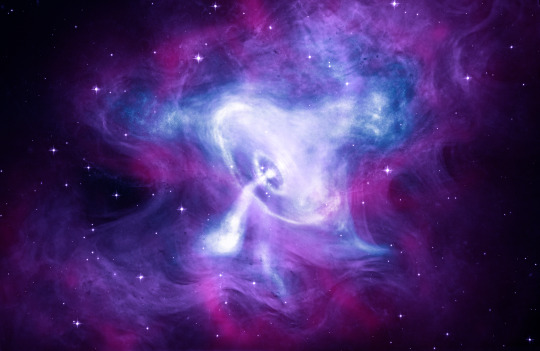
Navigating Deep Space by Starlight
On August 6, 1967, astrophysicist Jocelyn Bell Burnell noticed a blip in her radio telescope data. And then another. Eventually, Bell Burnell figured out that these blips, or pulses, were not from people or machines.

The blips were constant. There was something in space that was pulsing in a regular pattern, and Bell Burnell figured out that it was a pulsar: a rapidly spinning neutron star emitting beams of light. Neutron stars are superdense objects created when a massive star dies. Not only are they dense, but neutron stars can also spin really fast! Every star we observe spins, and due to a property called angular momentum, as a collapsing star gets smaller and denser, it spins faster. It’s like how ice skaters spin faster as they bring their arms closer to their bodies and make the space that they take up smaller.

The pulses of light coming from these whirling stars are like the beacons spinning at the tops of lighthouses that help sailors safely approach the shore. As the pulsar spins, beams of radio waves (and other types of light) are swept out into the universe with each turn. The light appears and disappears from our view each time the star rotates.
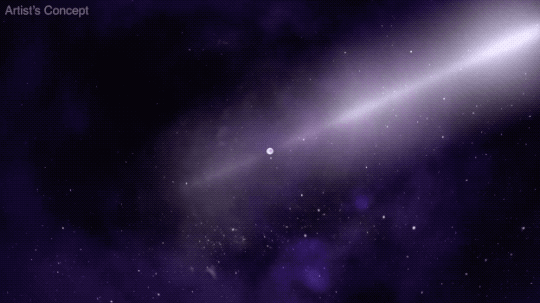
After decades of studying pulsars, astronomers wondered—could they serve as cosmic beacons to help future space explorers navigate the universe? To see if it could work, scientists needed to do some testing!
First, it was important to gather more data. NASA’s NICER, or Neutron star Interior Composition Explorer, is a telescope that was installed aboard the International Space Station in 2017. Its goal is to find out things about neutron stars like their sizes and densities, using an array of 56 special X-ray concentrators and sensitive detectors to capture and measure pulsars’ light.
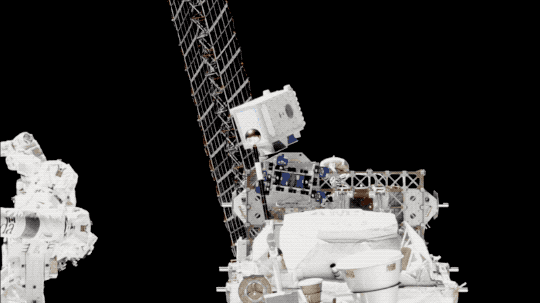
But how can we use these X-ray pulses as navigational tools? Enter SEXTANT, or Station Explorer for X-ray Timing and Navigation Technology. If NICER was your phone, SEXTANT would be like an app on it.
During the first few years of NICER’s observations, SEXTANT created an on-board navigation system using NICER’s pulsar data. It worked by measuring the consistent timing between each pulsar’s pulses to map a set of cosmic beacons.
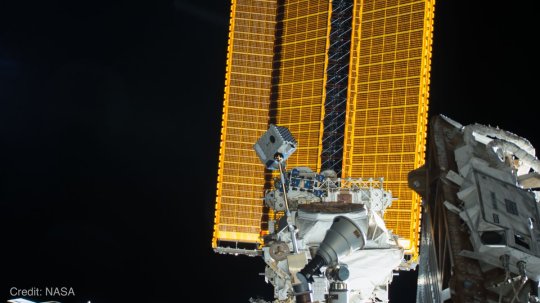
When calculating position or location, extremely accurate timekeeping is essential. We usually rely on atomic clocks, which use the predictable fluctuations of atoms to tick away the seconds. These atomic clocks can be located on the ground or in space, like the ones on GPS satellites. However, our GPS system only works on or close to Earth, and onboard atomic clocks can be expensive and heavy. Using pulsar observations instead could give us free and reliable “clocks” for navigation. During its experiment, SEXTANT was able to successfully determine the space station’s orbital position!
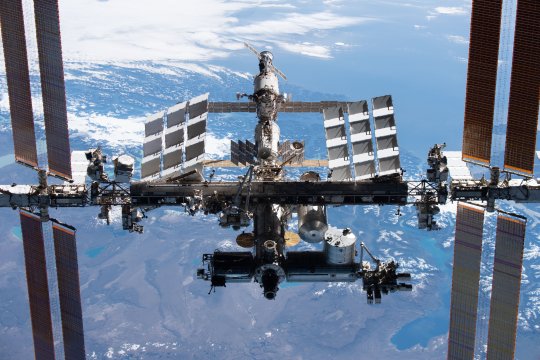
We can calculate distances using the time taken for a signal to travel between two objects to determine a spacecraft’s approximate location relative to those objects. However, we would need to observe more pulsars to pinpoint a more exact location of a spacecraft. As SEXTANT gathered signals from multiple pulsars, it could more accurately derive its position in space.
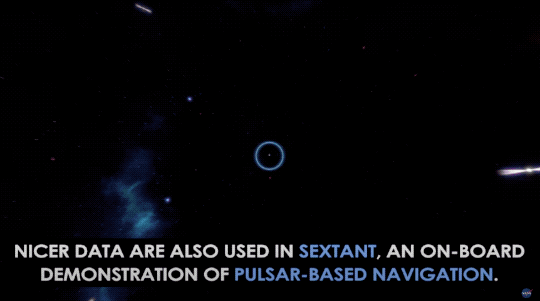
So, imagine you are an astronaut on a lengthy journey to the outer solar system. You could use the technology developed by SEXTANT to help plot your course. Since pulsars are reliable and consistent in their spins, you wouldn’t need Wi-Fi or cell service to figure out where you were in relation to your destination. The pulsar-based navigation data could even help you figure out your ETA!
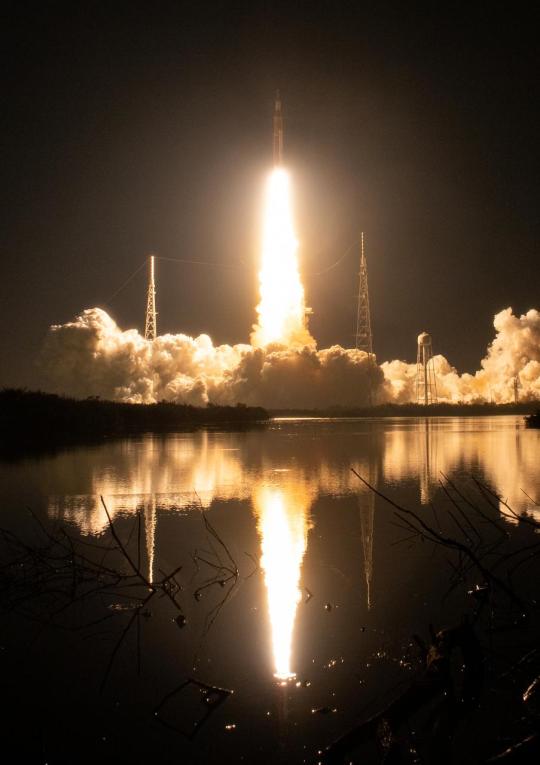
None of these missions or experiments would be possible without Jocelyn Bell Burnell’s keen eye for an odd spot in her radio data decades ago, which set the stage for the idea to use spinning neutron stars as a celestial GPS. Her contribution to the field of astrophysics laid the groundwork for research benefitting the people of the future, who yearn to sail amongst the stars.
Keep up with the latest NICER news by following NASA Universe on X and Facebook and check out the mission’s website. For more on space navigation, follow @NASASCaN on X or visit NASA’s Space Communications and Navigation website.
Make sure to follow us on Tumblr for your regular dose of space!
#NASA#pulsar#Jocelyn Bell Burnell#spaceblr#space#star#neutron star#deep space#telescope#navigation#universe#astronomy#science
4K notes
·
View notes
Text
Astronomers have discovered the slowest spinning radio wave-blasting neutron star ever seen; it takes almost an hour to complete a full rotation. That may sound rather fast, but these dead stars are known to spin so rapidly that some experience 700 full turns every second. Even the most leisurely of the about 3,000 radio-emitting neutron stars, or "pulsars," discovered so far complete a full rotation in a second or so. This ultra-leisurely neutron star, however, designated ASKAP J1935+2148 and located 16,000 light-years from Earth, is emitting radio light at a rate too slow to even fit with current theories describing the behavior of these dense stellar remnants.
Continue Reading.
793 notes
·
View notes
Text
Y'all, I'm getting emotional.
One of my absolute favorite astronomical bodies is the Crab Nebula, or Messier 1. The Crab Nebula is a "planetary nebula", which means it's the enormous, beautiful corpse of a once-giant star. The star that formed the Crab Nebula went supernova and exploded in 1054, and was so bright at the time of its death that you could see it from Earth during the day - for almost a month. For that month, it was brighter than every single thing in the sky except the moon and the sun. Some of you have probably heard of it, or have at least seen this Hubble picture:
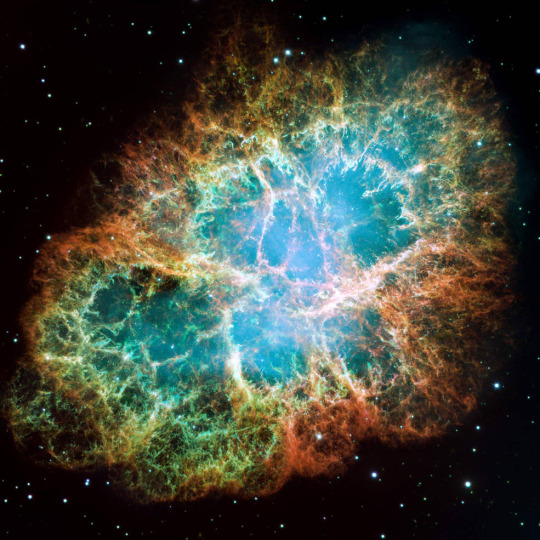
But how many of y'all have zoomed in?
Inside all of those lovely rainbow clouds is the supernova remnant - a neutron star. A neutron star is made of the densest possible material that we know of - any denser, and it'd collapse the rest of the way into a full-fledged black hole. Neutron stars are so unimaginably dense that they're not even made of an element, not really. The star at the center of the Crab Nebula is one, single atomic nucleus 12 miles in diameter, made entirely of close-packed neutrons. One teaspoon would weigh 10 million tons. Imagine taking a passenger jet, condensing it down to the size of a mote of dust, and then filling a spoon with that dust. And it spins too - 30 times a second. That spinning causes huge jets of material to eject from the poles at half the speed of light. The incredibly powerful magnetic field traps any stray particles and accelerates them in circular paths through the nebula. Just LOOK at this shit! See the ghosty shadows of the jets, stretching from the top left corner to the bottom right?
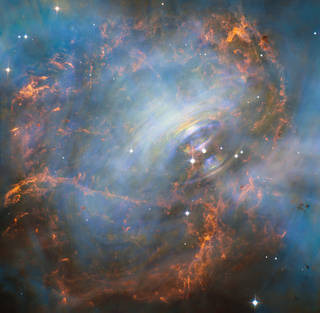
But what's really making me lose it is this Hubble timelapse. The star is making ripples. Its moving. Its been dead for almost a thousand years, but its still putting on its final, spectacular show.
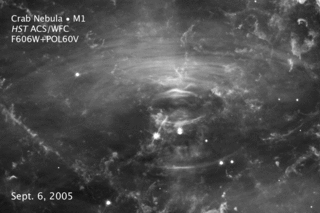
It never ceases to amaze me that the things we call "dead" stars are some of the most dynamic, energetic, and awe-inspiring objects in the universe. Normal stars are downright STAGNANT compared to what these so-called "stellar remnants" get up to. Maybe we shouldn't be thinking of them as dead stars, but as the next phase in a star's life. Just as caterpillars "end" their mundane lives and metamorphose into something new and strange and capable of flight, these stars destroy themselves to leave behind something far more exotic, playing at the edge of the laws of physics in ways we still don't fully understand.
#space#crab nebula#neutron star#supernova#god I fucking love neutron stars#ask me sometime about the first pulsar#hubble#spost#space post
747 notes
·
View notes
Text

Supernova Remnant and Neutron Star - November 14th, 1996.
"A massive star ends life as a supernova, blasting its outer layers back to interstellar space. The spectacular death explosion is initiated by the collapse of what has become an impossibly dense stellar core. However, this core is not necessarily destroyed. Instead, it may be transformed into an exotic object with the density of an atomic nucleus but more total mass than the Sun - a neutron star. Directly viewing a neutron star is difficult because it is small (roughly 10 miles in diameter) and therefore dim, but newly formed in this violent crucible it is intensely hot, glowing in X-rays. Images from the ROSAT X-ray observatory above may offer a premier view of such a recently formed neutron star's X-ray glow. Pictured is the supernova remnant Puppis A, one of the brightest sources in the X-ray sky, with shocked gas clouds still expanding and radiating X-rays. In the inset close-up view, a faint pinpoint source of X-rays is visible, which is most likely the young neutron star, kicked out by the asymmetric explosion and moving away from the site of the original supernova at about 600 miles per second."
54 notes
·
View notes
Text
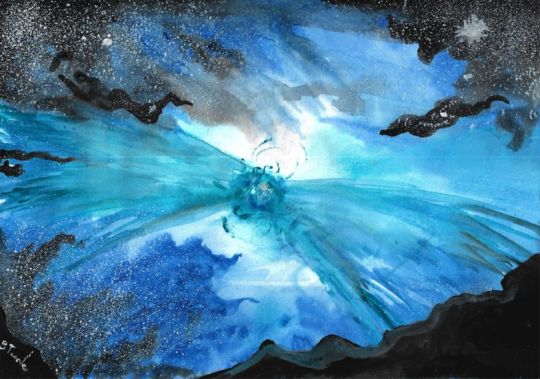
Watercolour neutron star
Watercolour interpretation of a neutron star which is the remnant core of a star that has gone supernova.
#artwork#art#artists on tumblr#space#science#astronomy#physics#cosmology#cosmic#cosmos#neutron star#pulsar#magnetar#gravity#magnetism#supernova#supernovae#abstract#watercolour#watercolor#painting#paint#gouche
20 notes
·
View notes
Text


"Neutron Spin" by Jeremy Jozwik. More images at source.
23 notes
·
View notes
Text

Entry 046
17-01-3311 19:32:11 Norma Expanse | Blaah Hypai FN-R D5-49
I apologise deeply for the extreme and severe delay in my log updates, as it has been..a few years, since I last made one of these. Getting into the centre of the galaxy is taxing on the mind and body. First thing that happened: I ran out of food on my ship due to a miscalculation on my part, and I was a sitting duck, so I had to call in some help from a friend, who came to rescue me. I was also going through a lot, mentally, separate from the food situation, but the food situation kind of made it worse. I knew that space madness and complete isolation in deep space throughout the journey was going to be something that ate away at me, I just didn’t know it could get this bad. The whole situation was a goddamn mess, so I decided to call off the journey for a while til I could get a grip on reality again.
I’ve spent much of my time winding down at various fleet carriers in the middle of deep space, as I’ve not wanted to go back to the bubble. I still want to complete my mission of going to the center of the galaxy, I just needed some time to think. I’ve been trying not to hitch any rides to further out places on those carriers, though. I do still want my journey to the center of the galaxy to be of my own doing, of course.
As I now currently have more motivation and spirit, and I have a much better plan for my food situations and can also plan my route based on the fleet carriers between me and Sagittarius A*, I think I’m in a lot better position than I was before. I’ve also allowed myself some proper time off, so I feel mentally and physically well enough to continue my journey. I’m genuinely almost half-way, now! It’s just...going to take some time.
Currently, as I type this, I’m in a planetary nebula which has a gorgeous neutron star in the centre of it, and also...a fleet carrier, who seems to be hanging just a tad bit too close to the neutron star. So close that I’m honestly a bit concerned. I will definitely not be landing on that carrier.
Anyways, I hope you like the pictures I’ve attached! Sorry there’s not many. There truly weren’t many planets in the nebula to look at. Just the nebula itself and the neutron star. My next stop will be another planetary nebula, and then after that, a very quick trip to the nearest fleet carrier in the Norma Arm. Hopefully one that hasn’t parked it’s rear end right in the face of a neutron star, this time!



#elite dangerous#asp explorer#space exploration#nebula#neutron star#planetary nebula#Norma Expanse#commanders log
8 notes
·
View notes
Text
siffrins are incredibly susceptible to mitosis
31 notes
·
View notes
Text
#augmented polls#polls#poll#tumblr polls#pollblr#astronomy#astrophysics#neutron star#neutron stars#space#polls about science
10 notes
·
View notes
Text


crab nebula
#crab nebula#jwst#james webb space telescope#nasa#taurus#supernova#observed by chinese in 1054#crab pulsar#neutron star
20 notes
·
View notes
Text
There's something strange on the outskirts of the Milky Way. In a cluster of stars skimming the outer reaches of the galaxy, astronomers have identified something very small, and very dense, locked in an orbital dance with a millisecond pulsar. There are, they say, only two things the mystery object could be – a neutron star or a black hole – but either one of those things would be an exciting find. If it's a neutron star, it could be the heaviest of its kind we've ever seen. If it's a black hole, it's the lightest of its kind.
Continue Reading.
108 notes
·
View notes
Text

Fall into the Infinite – Abstract Sci-Fi Art
This artwork invites the viewer to reflect on the vastness of the universe and our place within it. The swirling colors and intense depth convey both wonder and curiosity, drawing you deeper into the exploration of cosmic forces and infinite possibilities.

Visits us at: https://www.redbubble.com/shop/ap/165313063
#cosmic#sci fi#nebula#black hole#lava#neutron star#supernova#space#galactic#neon colors#event horizon#galaxy#abstract#stars#gasses
10 notes
·
View notes
Text

An article published in the journal "Nature" reports the identification of the origin of the fast radio burst cataloged as FRB 20221022A linking it to a magnetar-class neutron star, probably emerging from its magnetosphere. A team of researchers coordinated by MIT used observations conducted with the CHIME radio telescope to identify the origin of this already-known fast radio burst by exploiting the phenomenon of scintillation, comparable to how stars twinkle in the sky. This is further evidence of the link between magnetars and fast radio bursts, the very powerful emissions that can be one-time or repeated events.
8 notes
·
View notes
